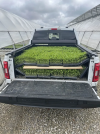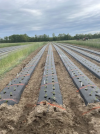When I was sampling for SCN it was pretty evident that eroded soil was a major carrier.I think that cleaning equipment would help. But there are things that can’t stop the spread. Wind, 4 legged critters. And a few things I will leave unsaid.
No forums found...
Site Related
Iowa State
College Sports
General - Non ISU
CF Archive
Install the app
2025 field work
- Thread starter BCClone
- Start date
No forums found...
Site Related
Iowa State
College Sports
General - Non ISU
CF Archive
You are using an out of date browser. It may not display this or other websites correctly.
You should upgrade or use an alternative browser.
You should upgrade or use an alternative browser.
So every field that a commercial applicator was in they should clean before going to another field so not to spread scn? That is asking a lot.
At the time, and this policy didn't last for long, the mission was to not carry soil from field to field. Or more accurately, from farmer to farmer. I don't see sprayers being an issue. Anhydrous toolbar? Yeah, maybe. But we were only going from place to place for planting.So every field that a commercial applicator was in they should clean before going to another field so not to spread scn? That is asking a lot.
I realize sprayers wouldn’t be as bad as an NH3 toolbar. But if you carry dirt from one field to another, you are going to carry the little nematodes along.
Until someone harrows over the marker linesShoot I still hand steer and use my markers on my planter. All the BTOs in the thread can laugh but it works for me.
LOL, Every once in a while Dad would end up in the same field I was field cultivating in add a extra round around the outside to make sure I didn't scrub out the planter lines.Until someone harrows over the marker lines
You embedded a penis joke in here but I can't find the whole thing yet.48 highs and 35 lows really makes this corn grow
2" of rain in the last couple days. soaked in well. Little to no standing water in our area.
Your photo speaks “labor” to me. I’m an asparagus junky and have a 16’ square patch that puts out a large cutting daily for 2 months. I visited an asparagus operation in NJ that had an 80 acre field that blew me away. I have ag family connections in YOLO County, Ca. that has thousands of acres of a variety of vegetables & fruits which I have explored. Question: how has mechanization and technology changed your labor requirements?View attachment 150288
got 2 different peppers installed yesterday. top row is an early red bell... bottom is an experimental yellow bell. only 4k plants each (200 cell tray x 20 trays) about 1/2 acre for each
Actual edible food?!? C'mon, you hippie!View attachment 150288
got 2 different peppers installed yesterday. top row is an early red bell... bottom is an experimental yellow bell. only 4k plants each (200 cell tray x 20 trays) about 1/2 acre for each
Your photo speaks “labor” to me. I’m an asparagus junky and have a 16’ square patch that puts out a large cutting daily for 2 months. I visited an asparagus operation in NJ that had an 80 acre field that blew me away. I have ag family connections in YOLO County, Ca. that has thousands of acres of a variety of vegetables & fruits which I have explored. Question: how has mechanization and technology changed your labor requirements?
So the majority of the larger farmers I work with all have H2A workers from Mexico... These are crews that are the same people who come back every year (they like Michigan summer much more than anywhere south).. awesome dudes/ ladies who are great at their jobs and work their asses off.. the biggest challenge is the pay from the farmers to these crews... something like $16.23/hour plus housing, travel TO and FROM Michigan back to Mexico.. at some point there will be from mechanization but we aren't there yet.... everything is planted by hand from 6 people sitting on a drawbar planter that goes across 3 beds or so..
the only area currently moving to mech on the veggie side (at least in the midwest/south) is sweet corn.... but as you know.. this requires a hybrid that can take more of a beating with less damage (lots of times can be bad tasting corn)... the large scale growers don't really care what it tastes like as long as its pretty and people buy it
Actual edible food?!? C'mon, you hippie!
oh the veggie growers i know are anything but a hippy
What is your goal for determining which move on? Larger peppers,, greater production per plant, taste, disease resistance, plant vigor, color, a combination of these factors or something altogether different?View attachment 150290
Here is an example of an early pipeline trial for bells... 22x new hybrids (I hand plant). We might get 1 or 2 that move on the rest will be killed.... you can see the crew planting in the background
looks very similar to a strawberry patch near me. rows of mounds with buried drip irrigation.View attachment 150290
Here is an example of an early pipeline trial for bells... 22x new hybrids (I hand plant). We might get 1 or 2 that move on the rest will be killed.... you can see the crew planting in the background
So these trials get yield (total and curve) color, maturity and size of fruit measurements. I have this trial in 4 locations in Michigan. My other teammates have them in their territories (eastern Canada, midatlantic, Carolinas. So the best will show itself. Usually midwest is a good bellwether (what works here can do well in others)What is your goal for determining which move on? Larger peppers,, greater production per plant, taste, disease resistance, plant vigor, color, a combination of these factors or something altogether different?
View attachment 150290
Here is an example of an early pipeline trial for bells... 22x new hybrids (I hand plant). We might get 1 or 2 that move on the rest will be killed.... you can see the crew planting in the background
Are they actually hybrids? Like with developed heterosis and separate inbred lines? And if so, how do you control pollen flow? Create an F1 hybrid?
Yes true hybrids. I work for one of the largest vegetable seed companies in the world (not owned by China). No real discussion about pollen flow (I’m not a breeder by training)Are they actually hybrids? Like with developed heterosis and separate inbred lines? And if so, how do you control pollen flow? Create an F1 hybrid?



